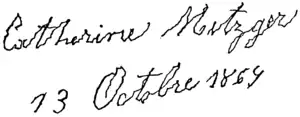Micrographia (handwriting)

Micrographia is an acquired disorder that features abnormally small, cramped handwriting or the progression to progressively smaller handwriting.[1] It is commonly associated with neurodegenerative disorders of the basal ganglia, such as in Parkinson's disease, but it has also been ascribed to subcortical focal lesions.[2] O'Sullivan and Schmitz describe it as an abnormally small handwriting that is difficult to read, as seen in the photo to the right.[3] Micrographia is also seen in patients with Wilson's disease, Obsessive Compulsive Disorder, Metamorphopsia, or with isolated focal lesions of the midbrain or basal ganglia.[1][4]
Parkinson's disease
A common feature of Parkinson's disease (PD) is difficulty in routine activities due to lack of motor control.[5] More specifically, patients have difficulty maintaining the scale of movements and have reduced amplitude of movement; also known as hypokinesia.[6] These difficulties with scaling and controlling the amplitude of movement cause patients with PD to have difficulty with complex, sequential movements.[5] This helps to explain why micrographia is a common symptom of the disease. Another reason is a lack of physical dexterity.
James Parkinson may have been aware of micrographia in patients with shaking palsy (later renamed Parkinson's disease), when he described "the hand failing to answer with exactness to the dictates of the will".[2]
Occurrence in Parkinson's
Micrographia is often seen patients with Parkinson’s disease, although the precise prevalence is uncertain, with reported figures of between 9% and 75%.[7] It often appears before other symptoms, so is potentially useful in diagnosis.[8]
Pharmacological management
Micrographia may worsen when a PD patient is under-medicated or when the effects of the medication are wearing off.[9]
References
- 1 2 A.J. Larner (12 November 2010). A Dictionary of Neurological Signs. Springer. p. 221. ISBN 978-1-4419-7095-4.
- 1 2 Encyclopedia of Movement Disorders, Three-Volume Set. Academic Press. 26 February 2010. ISBN 978-0-12-374105-9.
- ↑ O'Sullivan, pp. 1339
- ↑ Kinematic analysis of handwriting movements in patients with obsessive-compulsive disorder
- 1 2 O'Sullivan, pp. 858
- ↑ O'Sullivan, pp. 857
- ↑ Ziliotto A, Cersosimo MG, Micheli FE (2015). "Handwriting Rehabilitation in Parkinson Disease: A Pilot Study". Ann Rehabil Med. 39: 586–91. doi:10.5535/arm.2015.39.4.586. PMC 4564706. PMID 26361595.
- ↑ Robert B. Taylor (2 March 2013). Diagnostic Principles and Applications: Avoiding Medical Errors, Passing Board Exams, and Providing Informed Patient Care. Springer. pp. 57–. ISBN 978-1-4614-1111-6.
- ↑ Paul Tuite; Hubert Fernandez; Cathi Thomas; Laura Ruekert (23 March 2009). Parkinson's Disease: A Guide to Patient Care. Springer Publishing Company. p. 28. ISBN 978-0-8261-2269-8.
Bibliography
- O'Sullivan, Susan; Schmitz, Thomas (2007). Physical Rehabilitation. Philadelphia, PA: F.A. Davis Company. pp. 857–1339.